This listing features photographs of selected artworks, object assemblages and installations created by artists from continental Africa and the diaspora, as well as exhibition images taken in museums, galleries and institutes of fine art around the world. All the images were compiled by Carol Ann Dixon to enhance the appearance of the Museum Geographies site, and the page provides a dynamic and ever-changing visual narrative to accompany the featured articles and blog posts uploaded throughout the website.
Image credits, IPR statements and other acknowledgements are detailed in the descriptions, below, and are updated regularly.
COVER IMAGE:
Shango costume for the New Orleans Mardi Gras (2012), by carnival parade leader Chief Shaka Zulu, displayed at the Tropenmuseum, Amsterdam, August 2022. Photo: Carol Ann Dixon.
Textile installation by Abdoulaye Konaté (b. 1953, Diré, Mali), based in Bamako

This installation featuring religious symbolism was created by Abdoulaye Konaté – an internationally renowned Malian contemporary visual artist known for producing vast textile sculptures and wall-hangings called “les offrandes” (offerings). I was first introduced to Konaté’s portfolio at the exhibition “We Face Forward: Art From West Africa Today” (2012) in Manchester, UK, where his work was described as a unique merging of political commentary, symbols of religious faith and spirituality and traditional artistry – simultaneously communicating hope and an exploration of the human condition through thoughtful and critical expression. Although Abdoulaye Konaté has travelled and studied abroad in the Caribbean region (primarily in Cuba, where he lived for several years) and in Europe, he is mainly based in Bamako, Mali, and – in addition to his ongoing creation of new textile artworks – he is actively involved in teaching and supporting future strategic developments relating to visual arts as Director of the Conservatoire for Arts and Media in Bamako.
This photo was taken by Carol Ann Dixon at the 10th anniversary London edition of the 1:54 Contemporary African Art Fair (Somerset House, London, UK, October 2022).
“Pillars of Life” (2019) by Ethiopian artist Tadesse Mesfin (b. 1953, Weldia), based in Addis Ababa

Tadesse Mesfin’s oil painting celebrates the women who work as small-holder vendors in the street markets of Addis Ababa. All the images from his series “Pillars of Life” feature contemporary interpretations of female figures, depicted in columnar arrangement, and reflect an artistic inspiration derived from ancient Egyptian sculptures and mythological drawings. Mesfin’s figurative works tend to be minimal, with women being the sole inhabitants of the canvas. This photograph of the painting was taken at the 1:54 Contemporary African Art Fair, displayed at Somerset House in London in 2019. Photo: Carol Ann Dixon.
Flying Buddha (2016), by Ransome Stanley (British-born artist with Nigerian and German heritage, based in Germany)

This painting of the Flying Buddha (2016) by Munich-based artist Ransome Stanley (b. London, 1953) was one of the highlights of the 1:54 Contemporary African Art Fair presented as part of the ARTCO Gallery display at Somerset House in London during October 2016. The composition in oils on canvas was one of four featured works from an extensive portfolio themed around the juxtaposition of theatrical and mythical images popular in Western bourgeois society during the late-19th century. Ransome Stanley’s work makes very thought-provoking references (often through the use of satire, irony, caricatures and clichés) to the complex, exploitative, traumatic and racialized history of colonialism. His compositions also address (in quite playful, yet paradoxical and nuanced ways) the very serious socio-political, spatial and economic impacts of colonialism on relationships between individuals and communities brought into closer proximity as a result of transnational migrations, (re-)settlements, displacements and the dynamics of cultural hybridity. Stanley has described his own practice as “drawing from the ‘archive’ of the media and its industry to recontextualise its language through methods of appropriation and montage.” In every work, the recurring use of 19th century theatrical and circus-related symbolism forces the viewer to question and attempt to deconstruct and ‘de-code’ the cultural axioms and historical references – continuously re-assessing their changing meanings in relation to our 21st century lived experiences of multiculturalism, international mobility, technological changes and diaspora formations.
For further information about all the works shown at the 1:54 Art Fair, please see http://1-54.com/london/artists/ransome-stanley/. More detailed information about the artist’s biography and full portfolio of paintings are available via ARTCO Gallery at http://www.artco-ac.de/. Photo taken by Carol Ann Dixon (October 2016).
Exhibition view: ‘The Lost Dog’s Orchestra’ (Galerie Lelong, Paris, 2010), by Barthélémy Toguo (Cameroon)

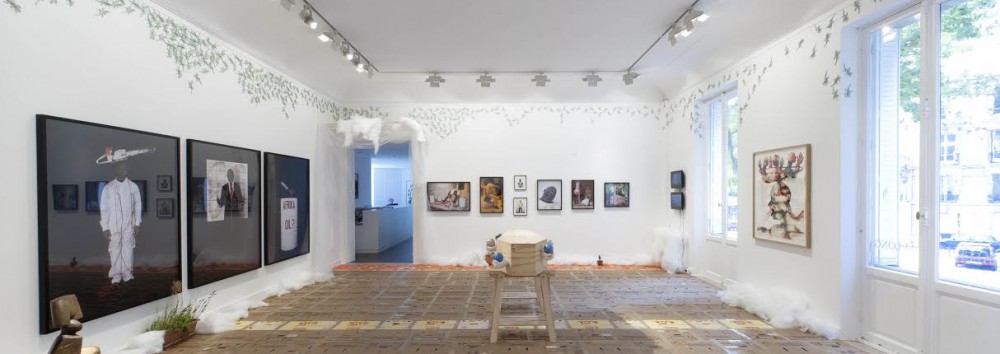

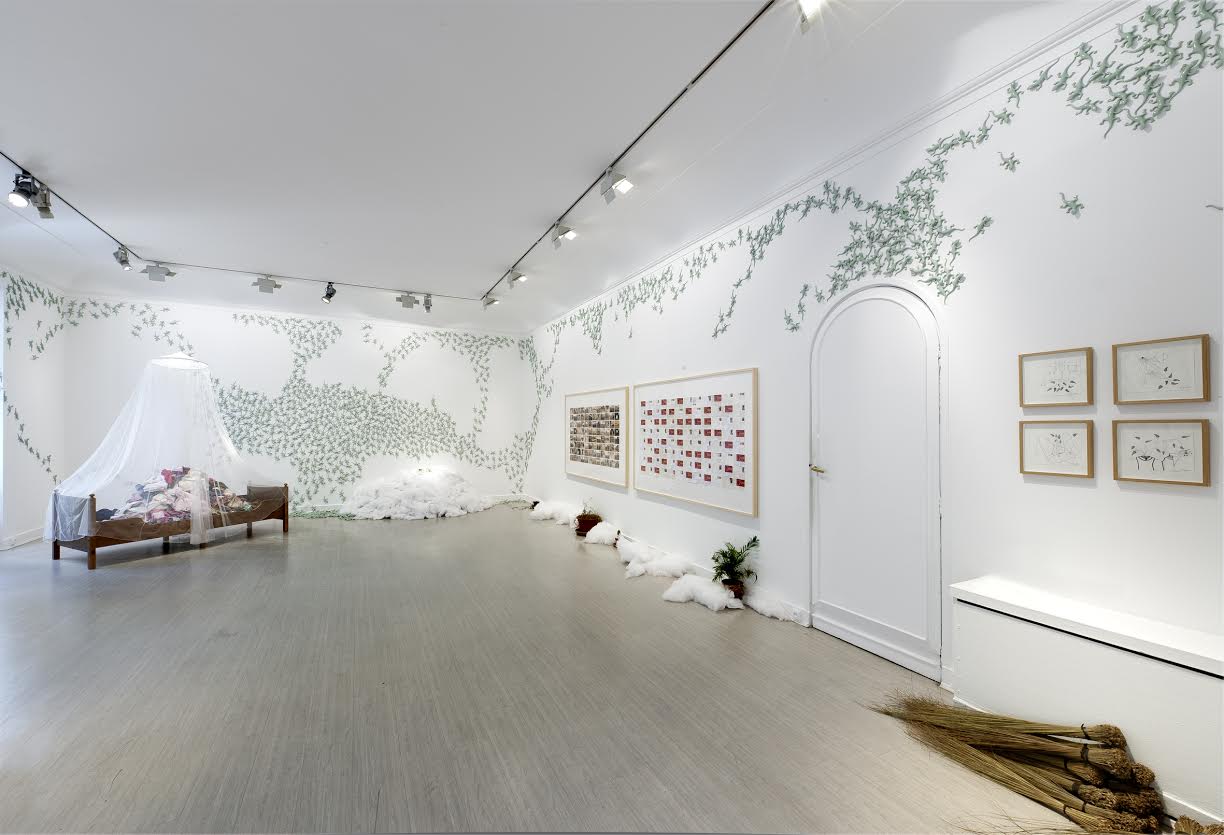
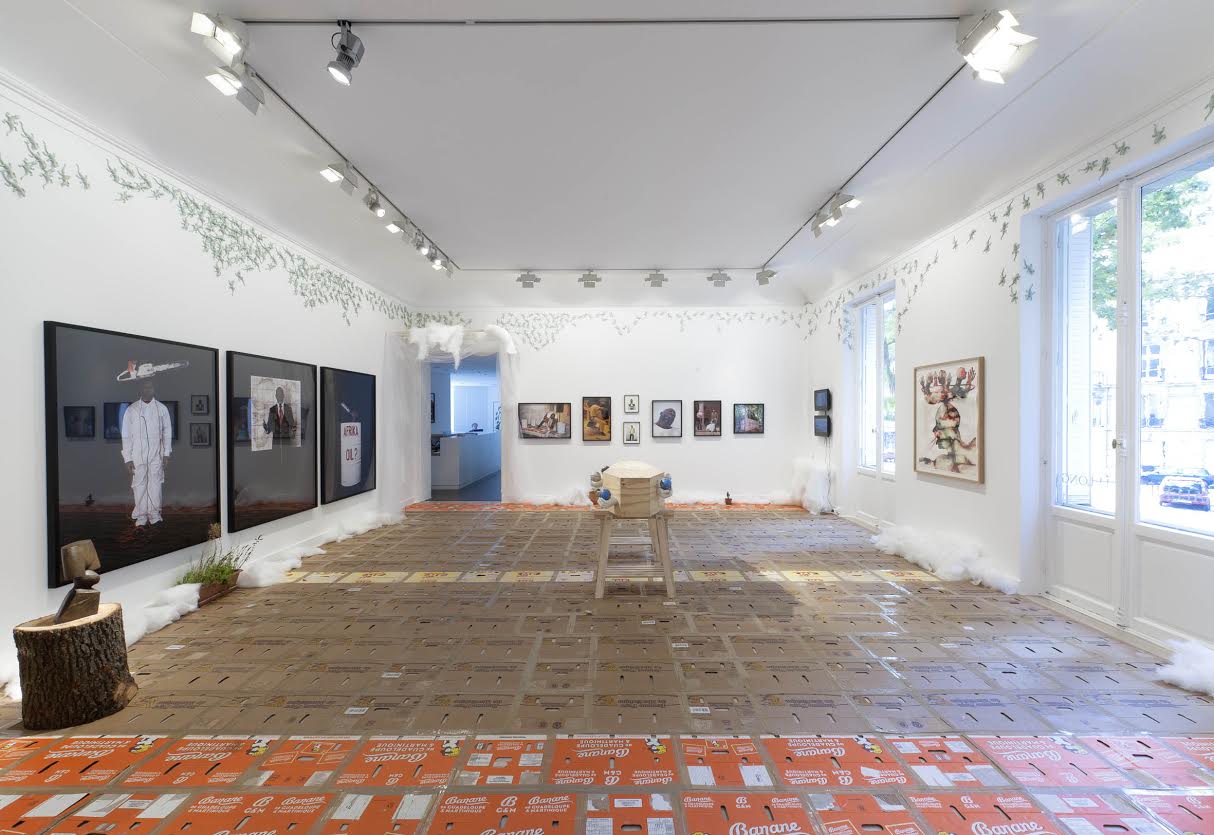
These artworks and installations by Barthélémy Toguo were presented as part of his solo exhibition for Galerie Lelong in Paris, ‘The Lost Dog’s Orchestra’ (2010). The coffin in the centre (‘Planet’s Destiny’, 2008) symbolises mourning, but the additional globes held in painted hands positioned around the structure also pose poignant questions about the future of the planet.
‘Baby’s Shelter’ (2010) by Barthélémy Toguo is shown in the corner of the gallery and comprises a bed, mosquito screen and piles of children’s clothing, while the gallery walls are covered with thousands of green porcelain salamanders, carefully grouped as ‘Night Invaders’ (2010).
The celebrated photographic triptych ‘Stupid African President’ (2005-2008) also features in this selection, while the entire gallery floor is covered with flattened cardboard boxes previously used to transport bananas. When viewed together the assemblage provides a powerful and poignant critique about many aspects of global politics, commerce and international trade links that have had a devastating impact on the economies and populations of countries in the Global South.
Overall, the ‘The Lost Dog’s Orchestra’ can be interpreted as the artist’s aesthetic representation of key environmental, political and socio-economic concerns facing contemporary societies around the world, but is also poetically described by Barthélémy Toguo himself as a “hymn to beauty”.
© Barthélémy Toguo & Bandjoun Station / Courtesy Galerie Lelong.
Self-portrait (c.1947), by Gerard Sekoto (South Africa)
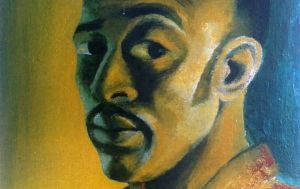
This self-portrait by South African artist Gerard Sekoto (1913-1993) was painted in 1946-1947. At that time during the apartheid era Sekoto became the first black South African artist to have one of his paintings displayed at the Johannesburg Art Gallery. Sekoto once said of this self-portrait:
‘”What you are reading from my expression is not fear, but mostly mistrust and deep agony about contradicting attitudes amongst people. I do not have a particular fear, but am looking into the future of our country with much anxiety, yet fully determined to live this life as everybody does – through using one’s own personal walking sticks.”
– Gerard Sekoto (Source: http://www.art.co.za/gerardsekoto/).
‘East African Encounters’ pop-up exhibition, by Circle Art Agency (Nairobi, June 2014)

This exhibition view shows a selection of artists’ works that were assembled as part of the Circle pop-up exhibition, ‘East African Encounters’ (Nairobi, June 2014). © Image courtesy of Circle Art Agency. The independent arts agency is based in Nairobi, and works to support and promote the contemporary art market throughout the East African region. Through arts consultancy, exhibitions and auctions they give talented artists from East Africa greater visibility, and also provide opportunities (locally, nationally and internationally) for more people to benefit from and enjoy the region’s fast-developing art scene. Further details are available online at http://www.circleartagency.com/
‘Peace (The Zionist series)’ (2010), by Mário Macilau (Mozambique)
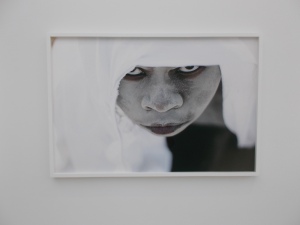
The dimensions of Mário Macilau‘s original artwork are 120 x 80 cm, printed on cotton rag paper. This close-up of the work was photographed at the Saatchi Gallery in London by Carol Dixon (August 2014) during a tour of the exhibition, Pangea: New Art from Africa and Latin America (2 April – 2 November 2014). Further details about Mário Macilau’s documentary photography are available on the Saatchi Gallery’s website. © Image courtesy of the photographer.
Photographic portraiture by Joana Choumali (Côte d’Ivoire/Ivory Coast)

Joana Choumali is an award-winning professional photographer based in Abidjan (Côte d’Ivoire). Her work has been exhibited internationally at exhibitions for the Bamako Photography Festival (2012), the Cultural Olympiad of the London Olympic & Paralympic Games (2012) and the Hierro des Villes Gallery in Nice, France (2014). In 2014 she received the POPCAP’14 Piclet.org Prize Africa and was also a recipient of a LensCulture Emerging Talents Award for the photographic series “Hââbré, the last generation.” A full biography and further details about Joana Choumali’s portfolio are available online at: http://joana-choumali.squarespace.com/. Image source: Pinterest.
‘African Icons’ (1987), by Eddie Chambers

This photograph of the four-part installation, African Icons (1987) by Eddie Chambers was taken at the Ikon Gallery in Birmingham where the artwork was displayed as part of the retrospective group exhibition, As Exciting As We Can Make It: Ikon in the 1980s (2 July – 31 August 2014). Artwork © Eddie Chambers. Photo by Stuart Whipps; Courtesy of the artist and Ikon.
‘The 99 Series’ (2013), by Aida Muluneh (Ethiopia)

This photograph was one of a series of images by Ethiopian photographer and artist Aida Muluneh that featured in the exhibition “The Divine Comedy: Heaven, Hell, Purgatory Revisited by Contemporary African Artists”, curated by Simon Njami and displayed at the Museum für Moderne Kunst ( MMK) in Frankfurt, Germany (21 March-27 July 2014) . Image source: MMK.
‘In the World But Don’t Know the World?’ (2009), by El Anatsui (Ghana)

This photograph of El Anatsui’s masterpiece – ‘In the World But Don’t Know the World?’ (2009) – was taken during a visit to the Manchester-based group exhibition ‘We Face Forward: Art from West Africa Today’(2 June – 16 September 2012), where it was exhibited alongside other large-scale textile sculptures by the Nigerian-American artist Nnenna Okore and Mali’s Abdoulaye Konaté. A close-up photograph does not do full justice to the sheer size and scale of El Anatsui’s artwork, but I wanted to feature it to convey just how rich, fluid and majestic such textiles can be when presented in the setting of an art space like Manchester Art Gallery. The beauty of El Anatsui’s work becomes even more mesmerizing and awe-inspiring when you get close enough to realise that the spectacle of sublime colours and shimmering lights has been constructed using thousands of recycled bottle caps, slivers of discarded aluminium sheets and other fragments of found waste metal, held together with copper wires. Every fragment and fold of this precious artwork tells its own story and is inscribed with narratives relating to the cultural geographies of global trade, commerce and industry. Photo taken by: Carol Ann Dixon (25 August 2012).
ADDITIONAL NOTES ON COPYRIGHT & REPRODUCTION
The artists, photographers, museums, galleries and art agents listed on this page retain copyright for the featured artworks and any exhibition photographs not taken by the author of this website. Only images that are already in the public domain – and/or for which permission has been sought to reproduce them – are presented above, and every artwork has been formally credited to the artist(s)/producer(s) concerned. Where relevant, links to the online source of the original digitized images have also been provided and are embedded in the written descriptions about each entry.
